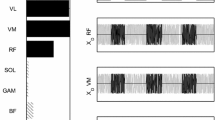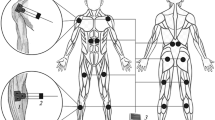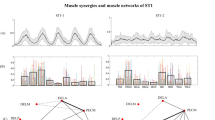Abstract
Muscle synergies are the building blocks for generating movement by the central nervous system (CNS). According to this hypothesis, CNS decreases the complexity of motor control by combination of a small number of muscle synergies. The aim of this work is to investigate similarity of muscle synergies during cycling across various mechanical conditions. Twenty healthy subjects performed three 6- min cycling tasks at over a range of rotational speed (40, 50, and 60 rpm) and resistant torque (3, 5, and 7 N/m). Surface electromyography (sEMG) signals were recorded during pedaling from eight muscles of the right and left legs. We extracted four synchronous muscle synergies by using the non-negative matrix factorization (NMF) method. Mean and standard deviation of the goodness of the signal reconstruction (R2) for all subjects was obtained 0.9898 ± 0.0535. We investigated the functional roles of both leg muscles during cycling by synchronous muscle synergy extraction. We compared the muscle synergies extracted from all subjects in all mechanical conditions. The total mean and standard deviation of the similarity of synergy vectors for all subjects in all mechanical conditions was obtained 0.8788 ± 0.0709. We found the high degrees of similarity among the sets of synchronous muscle synergies across mechanical conditions and also across different subjects. Our results demonstrated that different subjects at different mechanical conditions use the same motor control strategies for cycling, despite inter-individual variability of muscle patterns.








Similar content being viewed by others
References
Bernstein NA (1967) The co-ordination and regulation of movements. Pergamon Press, London
Latash ML, Gorniak S, Zatsiorsky VM (2008) Hierarchies of synergies in human movements. Kinesiology 40:29–38
Hug F, Turpin NA, Couturier A, Dorel S (2011) Consistency of muscle synergies during pedaling across different mechanical constraints. J Neurophysiol 106(1):91–103
Ting LH, Chvatal SA (2010) Decomposing muscle activity in motor tasks. In: Danion F, Latash ML (eds) Motor control theories, experiments and applications. Oxford University Press, New York, pp 102–138
De Rugy A, Loeb GE, Carroll TJ (2013) Are muscle synergies useful for neural control? Front Comput Neurosci 7:19
d’Avella A, Giese M, Ivanenko YP, Schack T, Flash T (2015) Modularity in motor control: from muscle synergies to cognitive action representation. Front Comput Neurosci 9:126
Latash ML (2010) Stages in learning motor synergies: a view based on the equilibrium-point hypothesis. Hum Mov Sci 29(5):642–654
Oliveira AS, Gizzi L, Farina D, Kersting UG (2014) Motor modules of human locomotion: influence of EMG averaging, concatenation, and number of step cycles. Front Hum Neurosci 8:335
Costa-García A, Itkonen M, Yamasaki H, Shibata-Alnajjar F, Shimoda S (2018) A novel approach to the segmentation of sEMG data based on the activation and deactivation of muscle synergies during movement. IEEE Robot Autom Lett 3(3):1972–1977
d’Avella A, Lacquaniti F (2013) Control of reaching movements by muscle synergy combinations. Front Comput Neurosci 7:42
Coscia M, Cheung VC, Tropea P, Koenig A, Monaco V, Bennis C, Micera S, Bonato P (2014) The effect of arm weight support on upper limb muscle synergies during reaching movements. J Neuroeng Rehabil 11(1):22
Scano A, Chiavenna A, Malosio M, Molinari Tosatti L, Molteni F (2017) Muscle synergies-based characterization and clustering of poststroke patients in reaching movements. Front Bioeng Biotechnol 5:62
D’Andola M, Cesqui B, Fernandez L, D’Avella A (2013) Spatiotemporal characteristics of muscle patterns for ball catching. Front Comput Neurosci 7:107
Chvatal SA, Ting LH (2013) Common muscle synergies for balance and walking. Front Comput Neurosci 7:48
Kim Y, Bulea TC, Damiano DL (2016) Novel methods to enhance precision and reliability in muscle synergy identification during walking. Front Hum Neurosci 10:455
Rimini D, Agostini V, Knaflitz M (2017) Evaluation of muscle synergies stability in human locomotion: a comparison between normal and fast walking speed. In: IEEE international instrumentation and measurement technology conference (I2MTC), Turin, Italy, IEEE. https://doi.org/10.1109/I2MTC.2017.7969722
Jacobs DA, Koller JR, Steele KM, Ferris DP (2018) Motor modules during adaptation to walking in a powered ankle exoskeleton. J Neuroeng Rehabil 15(1):2
Matsunaga N, Imai A, Kaneoka K (2017) Comparison of muscle synergies before and after 10 minutes of running. J Phys Ther Sci 29(7):1242–1246
Nishida K, Hagio S, Kibushi B, Moritani T, Kouzaki M (2017) Comparison of muscle synergies for running between different foot strike patterns. PLoS ONE 12(2):e0171535
An Q, Yamakawa H, Yamashita A, Asama H (2017) Different temporal structure of muscle synergy between sit-to-walk and sit-to-stand motions in human standing leg. Converging clinical and engineering research on neurorehabilitation II. Biosys Biorobot 15:933–937. https://doi.org/10.1007/978-3-319-46669-9_151
Yang N, An Q, Yamakawa H, Tamura Y, Yamashita A, Asama H (2017) Clarification of muscle synergy structure during standing-up motion of healthy young, elderly and post-stroke patients. In: IEEE international conference on rehabilitation robotics (ICORR), London, UK, IEEE, pp 19–24. https://doi.org/10.1109/ICORR.2017.8009215
Oliveira AS, Gizzi L, Ketabi S, Farina D, Kersting UG (2016) Modular control of treadmill vs overground running. PLoS ONE 11(4):e0153307
Saito A, Tomita A, Ando R, Watanabe K, Akima H (2018) Similarity of muscle synergies extracted from the lower limb including the deep muscles between level and uphill treadmill walking. Gait Posture 59:134–139
Kibushi B, Hagio S, Moritani T, Kouzaki M (2018) Speed-dependent modulation of muscle activity based on muscle synergies during treadmill walking. Front Hum Neurosci 12:4
De Marchis C, Castronovo AM, Bibbo D, Schmid M, Conforto S (2012) Muscle synergies are consistent when pedaling under different biomechanical demands. In: 34th Annual international conference of the IEEE Engineering in Medicine and Biology Society (EMBS), San Diego, California, USA, pp 3308–3311. https://doi.org/10.1109/EMBC.2012.6346672
Saito A, Watanabe K, Akima H (2015) Coordination among thigh muscles including the vastus intermedius and adductor magnus at different cycling intensities. Hum Mov Sci 40:14–23
Torricelli D, Tobaruela DN, De Marchis C, Barroso F, Pons JL (2016) Is modular control of cycling affected by learning? Preliminary results using muscle biofeedback. In: Converging clinical and engineering research on neurorehabilitation II;Biosys Biorobot 15:919–923
Hug F, Turpin NA, Guével A, Dorel S (2010) Is interindividual variability of EMG patterns in trained cyclists related to different muscle synergies? J Appl Physiol 108(6):1727–1736
Barroso FO, Torricelli D, Bravo-Esteban E, Taylor J, Gómez-Soriano J, Santos C, Moreno JC, Pons JL (2015) Muscle synergies in cycling after incomplete spinal cord injury: correlation with clinical measures of motor function and spasticity. Front Hum Neurosci 9:706
Turpin NA, Costes A, Moretto P, Watier B (2017) Can muscle coordination explain the advantage of using the standing position during intense cycling? J Sci Med Sport 20(6):611–616
De Marchis C, Schmid M, Bibbo D, Bernabucci I, Conforto S (2013) Inter-individual variability of forces and modular muscle coordination in cycling: a study on untrained subjects. Hum Mov Sci 32(6):1480–1494
De Marchis C, Severini G, Castronovo AM, Schmid M, Conforto S (2015) Intermuscular coherence contributions in synergistic muscles during pedaling. Exp Brain Res 233(6):1907–1919
Hug F, Dorel S (2009) Electromyographic analysis of pedaling: a review. J Electromyogr Kinesiol 19(2):182–198
Momeni K, Faghri PD, Evans M (2014) Lower-extremity joint kinematics and muscle activations during semi-reclined cycling at different workloads in healthy individuals. J Neuroeng Rehabil 11(1):146
Tang L, Li F, Cao S, Zhang X, Wu D, Chen X (2015) Muscle synergy analysis in children with cerebral palsy. J Neural Eng 12(4):046017
Blake OM, Champoux Y, Wakeling JM (2012) Muscle coordination patterns for efficient cycling. Med Sci Sports Exerc 44(5):926–938
So RC, Ng JKF, Ng GY (2005) Muscle recruitment pattern in cycling: a review. Phys Ther Sport 6(2):89–96
Hug F (2011) Can muscle coordination be precisely studied by surface electromyography? J Electromyogr Kinesiol 21(1):1–12
McKay JL, Ting LH (2007) Functional muscle synergies constrain force production during postural tasks. J Biomech 41(2):299–306
Wojtara T, Alnajjar F, Shimoda S, Kimura H (2014) Muscle synergy stability and human balance maintenance. J Neuroeng Rehabil 11(1):129
Li Y, Ngom A (2013) The non-negative matrix factorization toolbox for biological data mining. Source Code Biol Med 8(1):10
Tresch MC, Cheung VC, d’Avella A (2006) Matrix factorization algorithms for the identification of muscle synergies: evaluation on simulated and experimental data sets. J Neurophysiol 95(4):2199–2212
Cheung VC, Piron L, Agostini M, Silvoni S, Turolla A, Bizzi E (2009) Stability of muscle synergies for voluntary actions after cortical stroke in humans. Proc Natl Acad Sci USA 106(46):19563–19568
Berry MW, Browne M, Langville AN, Pauca VP, Plemmons RJ (2007) Algorithms and applications for approximate nonnegative matrix factorization. Comput Stat Data An 52(1):155–173
Choi C, Kim J (2011) Synergy matrices to estimate fluid wrist movements by surface electromyography. Med Eng Phys 33(8):916–923
Gentner R, Edmunds T, Pai DK, d’Avella A (2013) Robustness of muscle synergies during visuomotor adaptation. Front Comput Neurosci 7:120
Delis I, Berret B, Pozzo T, Panzeri S (2013) A methodology for assessing the effect of correlations among muscle synergy activations on task-discriminating information. Front Comput Neurosci 7:54
Chiovetto E, Huber ME, Sternad D, Giese MA (2018) Low-dimensional organization of angular momentum during walking on a narrow beam. Sci Rep 8(1):95
Steele KM, Tresch MC, Perreault EJ (2013) The number and choice of muscles impact the results of muscle synergy analyses. Front Comput Neurosci 7:105
d’Avella A, Portone A, Lacquaniti F (2011) Superposition and modulation of muscle synergies for reaching in response to a change in target location. J Neurophysiol 106(6):2796–2812
d’Avella A, Portone A, Fernandez L, Lacquaniti F (2006) Control of fast-reaching movements by muscle synergy combinations. J Neurosci 26(30):7791–7810
Quandt F, Hummel FC (2014) The influence of functional electrical stimulation on hand motor recovery in stroke patients: a review. Exp Transl Stroke Med 6(1):9
Toledo-Peral CL, Gutiérrez-Martínez J, Mercado-Gutiérrez JA, Martín-Vignon-Whaley AI, Vera-Hernández A, Leija-Salas L (2018) sEMG signal acquisition strategy towards Hand FES Control. J Healthc Eng. https://doi.org/10.1155/2018/2350834
Alessandro C, Delis I, Nori F, Panzeri S, Berret B (2013) Muscle synergies in neuroscience and robotics: from input-space to task-space perspectives. Front Comput Neurosci 7:43
Ison M, Artemiadis P (2015) Proportional myoelectric control of robots: muscle synergy development drives performance enhancement, retainment, and generalization. IEEE Trans Robot 31(2):259–268
Taborri J, Agostini V, Artemiadis PK, Ghislieri M, Jacobs DA, Roh J, Rossi S (2018) Feasibility of muscle synergy outcomes in clinics, robotics, and sports: a systematic review. Appl Bionics Biomech. https://doi.org/10.1155/2018/3934698
Author information
Authors and Affiliations
Corresponding author
Ethics declarations
Conflict of interest
The authors declare that there are no conflicts of interest with this paper.
Ethical approval
All procedures performed in studies involving human participants were in accordance with the ethical standards of the 1964 Helsinki declaration and its later amendments or comparable ethical standards.
Informed consent
Informed consent was obtained from all individual participants included in the study.
Additional information
Publisher's Note
Springer Nature remains neutral with regard to jurisdictional claims in published maps and institutional affiliations.
Rights and permissions
About this article
Cite this article
Esmaeili, J., Maleki, A. Comparison of muscle synergies extracted from both legs during cycling at different mechanical conditions. Australas Phys Eng Sci Med 42, 827–838 (2019). https://doi.org/10.1007/s13246-019-00767-0
Received:
Accepted:
Published:
Issue Date:
DOI: https://doi.org/10.1007/s13246-019-00767-0




